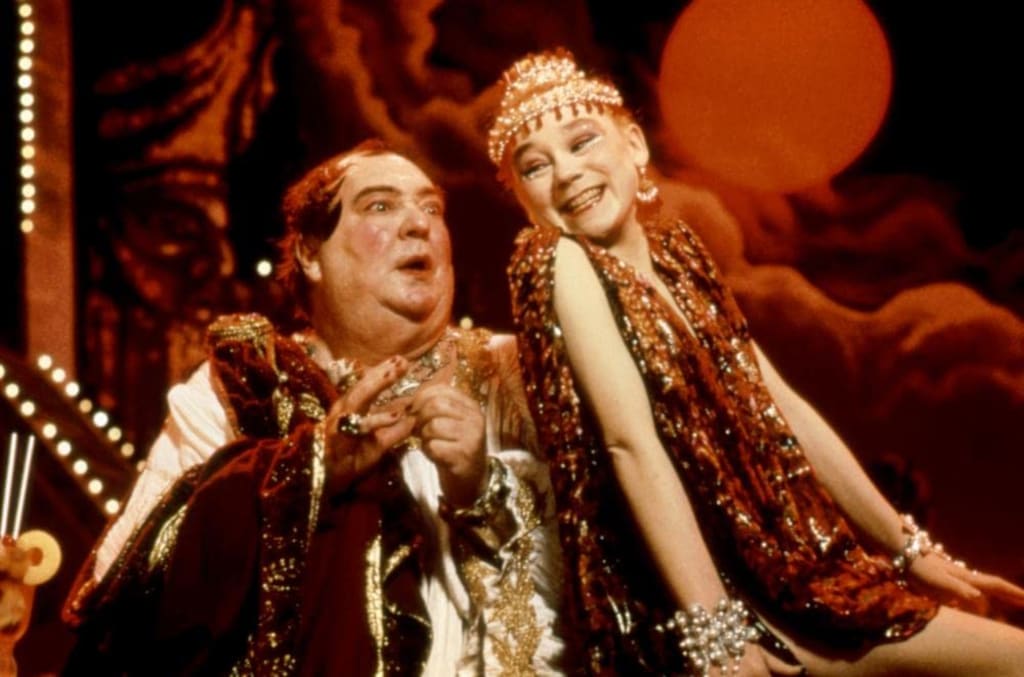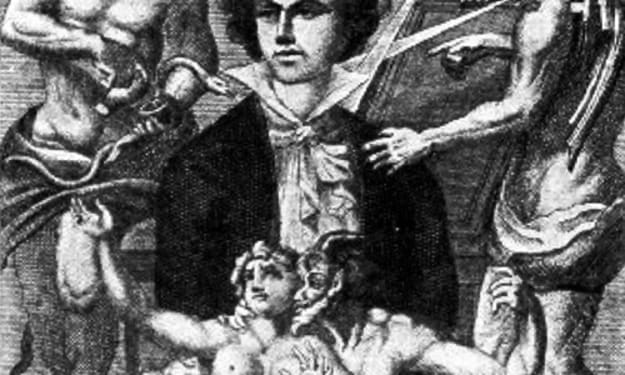
Ken Russell was one of the most incomparable film auteur's to have ever lived--his visually bold forays into cinematic excess were legendary and always riveting. Films such as Tommy, Lisztomania, Altered States, Aria, and Lair of the White Worm defined his style, his obsessive interest in pushing the envelope outward. In Salome's Last Dance, he presents Oscar Wilde's famous and initially banned play with a frame narrative featuring Wilde himself.
Lord Alfred Douglas (Stratford Johns) is the proprietor of a house of prostitution. He decides to stage a production of Oscar Wilde's banned play Salome, using his rather unconventional assortment of repertory players. Invited to attn=end as the sole audience is Wilde (Nickolas Grace). Lady Anne (Glenda Jackson, virtually unrecognizable in her makeup) plays the dual role of Herodias, and Lord Alfred himself out-Herods Herod.
Wilde's lover, Bosie (Douglas Hodge), plays John the Baptist, confined to a pit and eternally yelling out doom, saying imprecations against Herodias, the wife of Herod, formerly of his brother. The fantastic Imogen Millais-Scott, who appeared in only two other films, and of whom virtually no current information can be gleaned (she suffered much from diabetes and had a transplant operation in 2003), gives a surreal, hissing, serpentine performance as Salome, a young woman who seems equal parts love-struck teenager and bored, spoiled, amoral brat.
For the most part, The play is Wilde's, with few additions. The Roman guard is just as fixated on Salome as her Uncle Herod (whom she refers to constantly as "Tetrarch"). Still, Salome herself becomes infatuated and obsessed with John the Baptist, toward whom she invests her erotically-charged attention. Her performance is so bizarre, so utterly, perfectly fascinating; it is the film's chief appeal and what anyone is bound to take away from it upon viewing.
She is so hissing and seductive that one cannot help but be hypnotized by her--
“Salomé, Salomé, dance for me. I pray thee dance for me. I am sad to-night. Yes, I am passing sad to-night. When I came hither, I slipped in blood, which is an evil omen, and I heard, I am sure I heard in the air a beating of wings, a beating of giant wings. I cannot tell what they mean... I am sad to-night. Therefore dance for me. Dance for me, Salomé, I beseech you. If you dance for me, you may ask me what you will, and I will give it to you, even unto the half of my kingdom." ― Oscar Wilde, Salomé.
Herod, deeply in lust with his stepdaughter, is portrayed as fat and stupid. Herodias, by contrast, is the perfect wicked queen, enraged at the accusations yelled against her by John the Baptist. A kind of foreboding omen thrusts Herod into anxiety and despair ("I won't have him going around raising the dead," he comically intones, concerning reports that the Carpenter is traveling Judea, performing miracles), and he wonders at the meaning behind him having slipped in the blood of his captain of the guards, who has committed suicide. John's pronouncements seem to foretell the coming judgment against him by a righteous God, for his life's swinish idolatry and iniquity.
But, no matter, the rest of the film is a study in grotesques. The guardsmen are quaking, lust-besotted cowards, the servants bare-breasted courtesans with huge, pendulous tits. Most astonishingly, a trio of rabbis is portrayed, not as ancient Israelites, but as stereotypical caricatures of European Jewry, in a portrayal that would raise cries of outrage in our present era (indeed, they are even played by dwarf actors). This was, of course, not intentional anti-semitism; it in no way passes muster today.
Salome finally relents to dance for Herod, the infamous "Dance of the Seven Veils." A male body-double was used for the scene, as Imogen Millais-Scott was suffering from too many health issues to do the scene herself. In a weird, comic twist, this "Salome" flashes her male genitalia at the end of the dance.
Herod, the camera focusing on his fat, intoxicated features during the dance, asks Salome, as per his promise, what it is she would like to have as payment for her dance. She tells him the head of John the Baptist. he implores her to reconsider. But, finally, he keeps his word.
The head is resented on a silver platter, and Salome declares her love for it. "I was a virgin, and you raped me, John the Baptist!" Earlier she has told him, "The mystery of love is greater than the mystery of death. One must look only to love." The poetry of her dialog is an eternal testament to the genius embodied by Wilde and the resultant play.
Feverishly, Salome begins to tongue the dead mouth of John's severed head. Herod, disgusted, calls her "monstrous" (what did he think of himself, one wonders); Herodias says she approves of what her daughter has done.
At the end of the play, Herod commands his guard to kill Salome, which he does by throwing a spear through her. Wilde believes what he has seen is simply a dramatic effect, but, indeed, Salome has really been killed.
Victorian police officers come to arrest them, looking as if they were cast extras from some contemporary production of The Pirates of Penance. Wilde, Alfred, Bosie, and Lady Anne lead out to the paddy wagon. Two police carry out the body of Salome, saying, "A chambermaid has been murdered."
Strangely, Lady Anne says, "Nonsense! It was death by misadventure! She slipped on a banana peel." The camera focuses on her in a close-up. The wagon pulls away, the people inside laughing at her joke. The viewer is left puzzled. Shakespeare wrote, in Hamlet, "The play's the thing / Wherein I'll catch the conscience of the King." Here, no one seems to have had any conscience: not the performers, not the playwright.
Salome was made famous during the silent era by a film adaption starring Nazimova, who was a gorgeous diva of her age. The visual appeal in this version is just as stunning. The viewer will often forget they're watching a filmed play and forget altogether about the frame narrative. They will be taken by the incredible Imogen Scott-Millais, the masterful dialog, and the genius with which Oscar Wilde reimagined a Biblical masterpiece.
Salome's Last Dance - Clip
About the Creator
Tom Baker
Author of Haunted Indianapolis, Indiana Ghost Folklore, Midwest Maniacs, Midwest UFOs and Beyond, Scary Urban Legends, 50 Famous Fables and Folk Tales, and Notorious Crimes of the Upper Midwest.: http://tombakerbooks.weebly.com






Comments
There are no comments for this story
Be the first to respond and start the conversation.